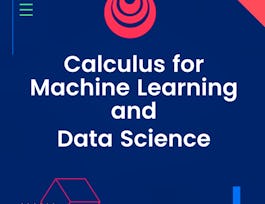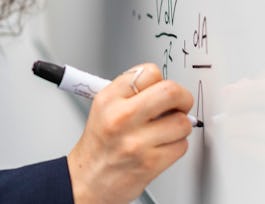This course continues your study of calculus by introducing the notions of series, sequences, and integration. These foundational tools allow us to develop the theory and applications of the second major tool of calculus: the integral. Rather than measure rates of change, the integral provides a means for measuring the accumulation of a quantity over some interval of input values. This notion of accumulation can be applied to different quantities, including money, populations, weight, area, volume, and air pollutants. The concepts in this course apply to many other disciplines outside of traditional mathematics. Through projects, we will apply the tools of this course to analyze and model real world data, and from that analysis give critiques of policy.

Offrez à votre carrière le cadeau de Coursera Plus avec $160 de réduction, facturé annuellement. Économisez aujourd’hui.


Calculus through Data & Modelling: Series and Integration
Ce cours fait partie de Spécialisation Integral Calculus through Data and Modeling

Instructeur : Joseph W. Cutrone, PhD
Enseignant de premier plan
5 023 déjà inscrits
Inclus avec 
(42 avis)
Détails à connaître

Ajouter à votre profil LinkedIn
6 devoirs
Découvrez comment les employés des entreprises prestigieuses maîtrisent des compétences recherchées

Élaborez votre expertise du sujet
- Apprenez de nouveaux concepts auprès d'experts du secteur
- Acquérez une compréhension de base d'un sujet ou d'un outil
- Développez des compétences professionnelles avec des projets pratiques
- Obtenez un certificat professionnel partageable


Obtenez un certificat professionnel
Ajoutez cette qualification à votre profil LinkedIn ou à votre CV
Partagez-le sur les réseaux sociaux et dans votre évaluation de performance

Il y a 5 modules dans ce cours
Calculus is divided into two halves: differentiation and integration. In this module, we introduce the process of integration. First we will see how the definite integral can be used to find the area under the graph of a curve. Then, we will investigate how differentiation and integration are inverses of each other, through the Fundamental Theorem of Calculus. Finally, we will learn about the indefinite integral, and use some strategies for computing integrals.
Inclus
3 vidéos1 lecture1 devoir
In this module, we introduce the notion of Riemann Sums. In mathematics, a Riemann sum is a certain kind of approximation of an integral by a finite sum, named after nineteenth century German mathematician Bernhard Riemann. One very common application is approximating the area of functions or lines on a graph, but also the length of curves and other approximations. This notion of approximating the accumulation of area under a group will lead to the concept of the definite integral, and the many applications that follow.
Inclus
5 vidéos1 lecture1 devoir
We now introduce the first major tool of our studies, the Fundamental Theorem of Calculus. This deep theorem links the concept of differentiating a function with the concept of integrating a function. The theorem will consists of two parts, the first of which implies the existence of antiderivatives for continuous functions and the second of which plays a larger role in practical applications. The beauty and practicality of this theorem allows us to avoid numerical integration to compute integrals, thus providing a better numerical accuracy.
Inclus
2 vidéos1 lecture1 devoir
In this module, we focus on developing our ability to find antiderivatives, or more generally, families of antiderivatives. In calculus, the general family of antiderivatives is denoted with an indefinite integral, and the process of solving for antiderivatives is called antidifferentiation. This is the opposite of differentiation and completes our knowledge of the two major tools of calculus. Antiderivatives are related to definite integrals through the fundamental theorem of calculus: the definite integral of a function over an interval is equal to the difference between the values of an antiderivative evaluated at the endpoints of the interval.
Inclus
5 vidéos2 lectures2 devoirs
While the technique of finding antiderivatives is useful, there are some functions that are just too difficult to find antiderivatives for. In cases like these, we want to have a numerical method to approximate the definite integral. In this module, we introduce two techniques for solving complicated integrals: using technology or tables of integrals, as well as estimation techniques. We then apply our knowledge to analyze strategies and decision theory as applied to random events.
Inclus
1 vidéo1 lecture1 devoir1 évaluation par les pairs
Instructeur

Offert par
Recommandé si vous êtes intéressé(e) par Math and Logic

DeepLearning.AI

Johns Hopkins University

Johns Hopkins University

University of Colorado Boulder
Pour quelles raisons les étudiants sur Coursera nous choisissent-ils pour leur carrière ?




Avis des étudiants
Affichage de 3 sur 42
42 avis
- 5 stars
95,23 %
- 4 stars
4,76 %
- 3 stars
0 %
- 2 stars
0 %
- 1 star
0 %

Ouvrez de nouvelles portes avec Coursera Plus
Accès illimité à plus de 7 000 cours de renommée internationale, à des projets pratiques et à des programmes de certificats reconnus sur le marché du travail, tous inclus dans votre abonnement
Faites progresser votre carrière avec un diplôme en ligne
Obtenez un diplôme auprès d’universités de renommée mondiale - 100 % en ligne
Rejoignez plus de 3 400 entreprises mondiales qui ont choisi Coursera pour les affaires
Améliorez les compétences de vos employés pour exceller dans l’économie numérique
Foire Aux Questions
Access to lectures and assignments depends on your type of enrollment. If you take a course in audit mode, you will be able to see most course materials for free. To access graded assignments and to earn a Certificate, you will need to purchase the Certificate experience, during or after your audit. If you don't see the audit option:
The course may not offer an audit option. You can try a Free Trial instead, or apply for Financial Aid.
The course may offer 'Full Course, No Certificate' instead. This option lets you see all course materials, submit required assessments, and get a final grade. This also means that you will not be able to purchase a Certificate experience.
When you enroll in the course, you get access to all of the courses in the Specialization, and you earn a certificate when you complete the work. Your electronic Certificate will be added to your Accomplishments page - from there, you can print your Certificate or add it to your LinkedIn profile. If you only want to read and view the course content, you can audit the course for free.
If you subscribed, you get a 7-day free trial during which you can cancel at no penalty. After that, we don’t give refunds, but you can cancel your subscription at any time. See our full refund policy.

